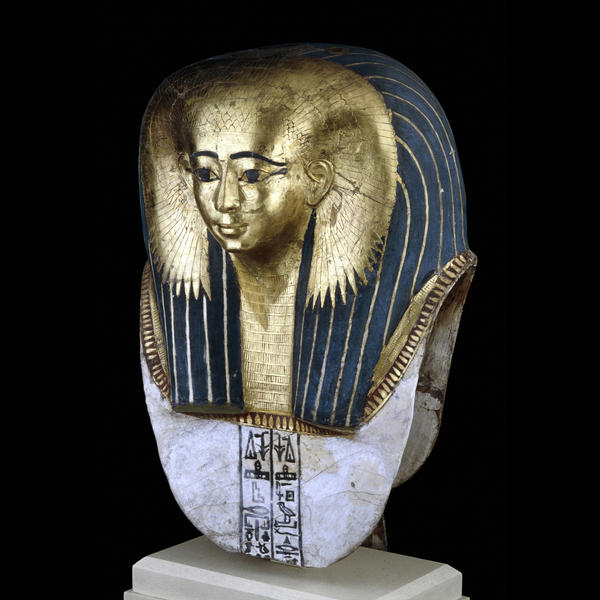 Ancient Civilizations...
Ancient Civilizations...
 Ancient Civilizations...
Ancient Civilizations...
Dr. Kathryn Denning
Anth 2150, Sept 2007 - Apr 2008
29 Jan 2008... Hi!

Plan for the day
1 Announcements.
Reading for Next Week, Jan 31 - Ancient Egypt Part 2
Continue exploring these sites:
Explore web feature on Ancient Egypt thoroughly: www.bbc.co.uk/history/ancient/egyptians/
Explore: www.digitalegypt.ucl.ac.uk/Welcome.html
Briefly explore Hierakonpolis: www.archaeology.org/interactive/hierakonpolis/index.html
Particularly these parts:
The Private Lives of the Pyramid Builders: www.bbc.co.uk/history/ancient/egyptians/pyramid_builders_01.shtml
The Decipherment of Hieroglyphs
www.bbc.co.uk/history/ancient/egyptians/decipherment_01.shtml
Burial Customs: www.digitalegypt.ucl.ac.uk/burialcustoms/index.html
The museum assignment - online now. Note: The due date is now February 27th (instead of Feb 20th).
2 Lecture - EGYPT
Today's reading was this:
Review Fagan pp 337-348
Explore web feature on Ancient Egypt thoroughly: www.bbc.co.uk/history/ancient/egyptians/
Explore: www.digitalegypt.ucl.ac.uk/Welcome.html
Briefly explore Hierakonpolis: www.archaeology.org/interactive/hierakonpolis/index.html
And part of the film... The Mummy Who Would Be King (Nova, 2006) --- rest to be shown and discussed in tutorial tomorrow.
EGYPT
From our previous overview of Egypt...
Ozymandias.... King of Kings...

1817: English poet Percy Bysshe Shelley publishes his sonnet “Ozymandias”
I met a traveller from an antique land
Who said: Two vast and trunkless legs of stone
Stand in the desert. Near them, on the sand,
Half sunk, a shattered visage lies, whose frown,
And wrinkled lip, and sneer of cold command
Tell that its sculptor well those passions read
Which yet survive, stamped on these lifeless things,
The hand that mocked them, and the heart that fed:
And on the pedestal these words appear: ‘My name is Ozymandias, king of kings: Look on my works, ye mighty, and dispair!”
Nothing besides remains. Round the decay
Of that colossal wreck, boundless and bare,
The lone and level sands stretch far away.”
Accurate? Nope. Evocative? Definitely. Revealing of the English perception of Egypt as a place of dead history, surpassed by modern civilization? Just Maybe : )
A few things about Egypt
PLACE

 Nile: 6,825 km long!
Nile: 6,825 km long!


(Museum of Fine Arts, Boston)
below: Nile inundation
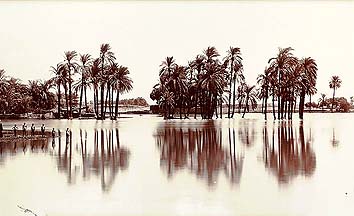
"
| This photo appears to have been taken during the time of the Nile's annual inundation. Rains in the highlands of Abysinnia swelled the Blue Nile, which met the White Nile at Khartoum and sent the rising, silt-laden waters north to cover the fields of Egypt. During the summer months Egypt disappeared beneath the brown waters, the whole of the land a vast sheet of water stretching from desert to desert, with the villages protruding like islands from the flood. In antiquity this was a time of increased navigation, festivals in honor of the inundation, booths and bowers on the edge of the swollen river, and festooned boats upon the waters. Since the building of the High Dam, the inundation no longer occurs in the Nile valley north of Aswan." |
"http://www-oi.uchicago.edu/OI/DEPT/PUB/CATALOG/LE2.2.html
ARCHAEOLOGY
Archaeological bonuses: burial rituals focused on deliberate preservation of bodies and burial goods; excellent natural preservation of sites because of hot, dry, sandy environment.
Other sources for information about the ancient Egyptians:
a) ancient historians, like Manetho, c. 300 BC, Egyptian historian and priest, whose works have not survived intact but are quoted in later historical works, e.g. by Jewish historian Josephus, first century AD. (oh, but what would we know if only the Library of Alexandria had not been destroyed!?)
b) ordinary documents
c) historical inscriptions on monuments themselves; pharaohs were constantly constructing their own histories, tracing lineages, recording their exploits, etc.
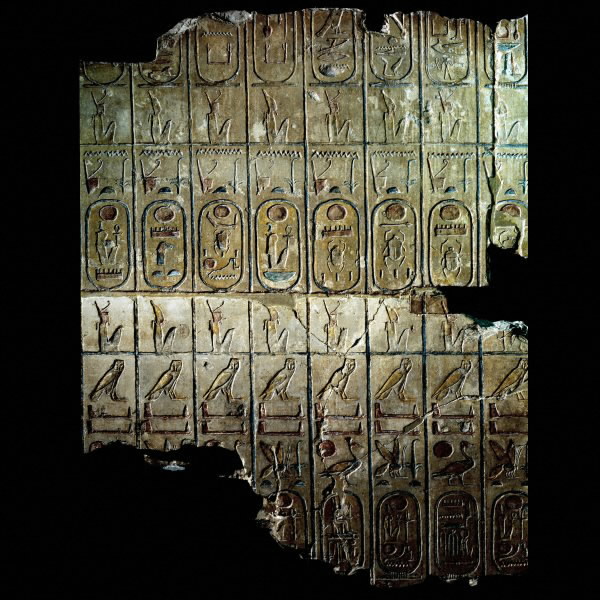
King List: 19th Dynasty, around 1250 BC, chronology of the rulers of Egypt so far, from a temple of Ramesses II.... but it is a selective list.
TIME
A good basic timeline: http://www.bbc.co.uk/history/ancient/egyptians/timeline.shtml
http://www.mfa.org/egypt/explore_ancient_egypt/learn_time.html
Predynastic Period: 5500 - 3100 BC.
0 Dynasty: Unification under Narmer and the Scorpion King.
First Dynasty 3050 - 2890 BC
Second Dynasty 2890 - 2686 BC
OLD KINGDOM: 2686 - 2181 BC. Centralised, unified government. Pharoah started to be divine.
Third Dynasty 2686 - 2613 BC: Djoser builds Step Pyramid at Saqqara.
Fourth Dynasty 2613 - 2498 BC: Khufu (Great Pyramid), Khafre (Sphinz, Second pyramid) and Menkaure build pyramids at Giza.
Fifth Dynasty 2498 - 2345 BC
Sixth Dynasty 2345 - 2181 BC
First Intermediate Period: 7th - 11th Dynasties 2181 - 2055 BC. A mess!
MIDDLE KINGDOM: 2055 - 1650 BC. Unified, prosperous, foreign trade, big building projects.
Mid-Eleventh Dynasty (Mentuhotep I) 2060 - 1991 BC
Twelfth Dynasty 1991 - 1782 BC
Thirteenth Dynasty 1782 - 1650 BC (first half only)
Second Intermediate period 1650 - 1570 BC. Periods of Hyksos rule.
New Kingdom: 1570 - 1070 BC. Again, centralized, unified government.
Eighteenth Dynasty 1570 - 1293 BC: a renaissance of art and building. Tuthmosis (multiple), Hapshetsut, Akhenaten, Tutankhamun
Nineteenth Dynasty 1293 - 1185 BC: Ramesses I, II, III, Seti I and II
Twentieth Dynasty 1185 - 1070 BC: Ramesses IV-XI. breakdown of government. Officials rob tombs and priests assume secular power.
Third Intermediate Period: 1070 - 664 BC. Includes periods of Libyan and Kushite rule.
Late Period: 664-332 BC: Includes periods of Persian rule.
Macedonian and Ptolemaic Period: 332 - 3O BC. Alexander the Great conquered Egypt in 332 BC, built Alexandria. His general Ptolemy I ultimately succeeded him -- and 14 more Ptolemies after that. Rosetta Stone. Cleopatra VII, daughter and co-regent of Ptolemy XII, and sister/co-regent of Ptolemy XIV, ruled Egypt at the end. (Romantic liaisons with Roman rulers Julius Caesar, Marc Anthony.... Rome declared war on Cleopatra/Egypt in 32 BC, and in 30 BC, Octavian, Julius Caesar's adopted son (later known as Roman Emperor Augustus), conquered Egypt and proclaimed himself Pharaoh. Egypt then part of the Roman Empire.
Roman rule: 30 BC - AD 395
Coptic Egypt: Christianity arrived in Egypt around 50AD with St. Mark, and a Christian community started in Alexandria. Eventually there were many (60?) Christian monasteries in Egypt and the religion was generally widespread. Difficulties came when the Romans under Diocletian started to suppress other religions, particularly Christianity. Much martyrdom for a period of about 30 years, 284-313 AD, until the Romans decided on a policy of tolerance again. Christianity continues in parts of Egypt to the present day.
Byzantine: AD 395-640 Ruled from Constantinople, predominantly Christian.
Islamic/Arab Period (Caliphate) Egypt: 640 AD onwards. Ruled from Damascus and from Baghdad.
Ottoman Period: AD 1517-1805. Ruled from Turkey.
Napoleon's expedition: circa 1800, short-lived.
Khedeval Period: AD 1805-1914
British Protectorate: AD 1914-1922
Monarchy: AD 1922-1953
Republic: AD 1953-
MONUMENTAL ARCHITECTURE
Giza Pyramids: Khufu, Khafre, and Menkaure (left, from right)
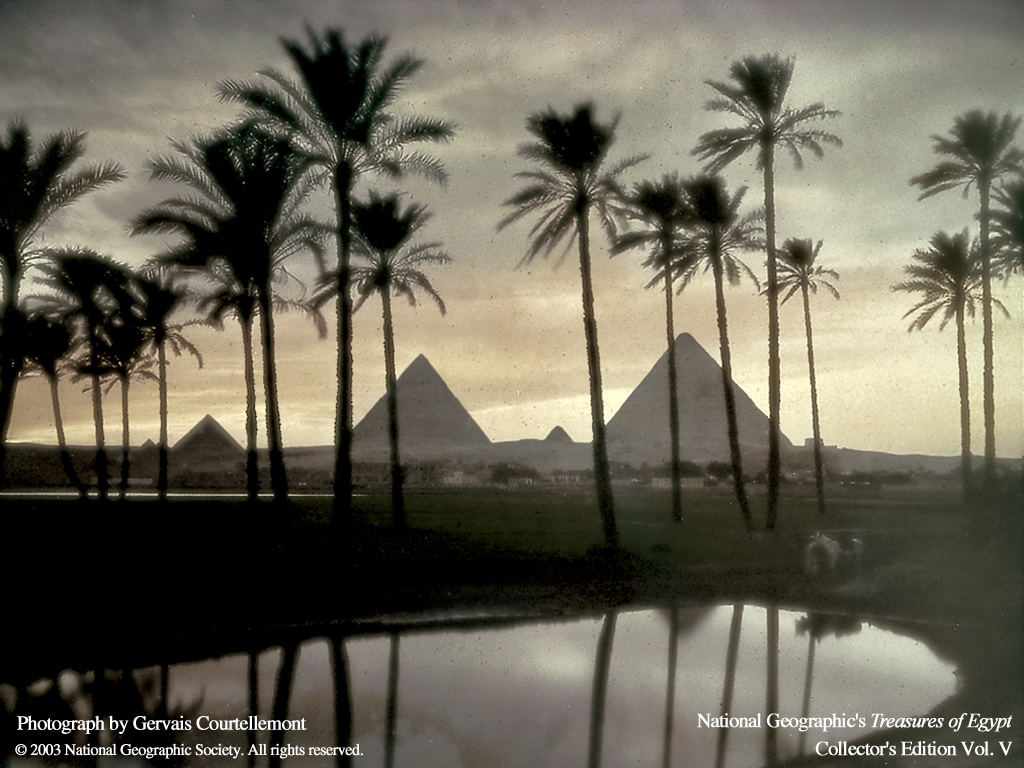
Great Pyramid of Cheops / Khufu
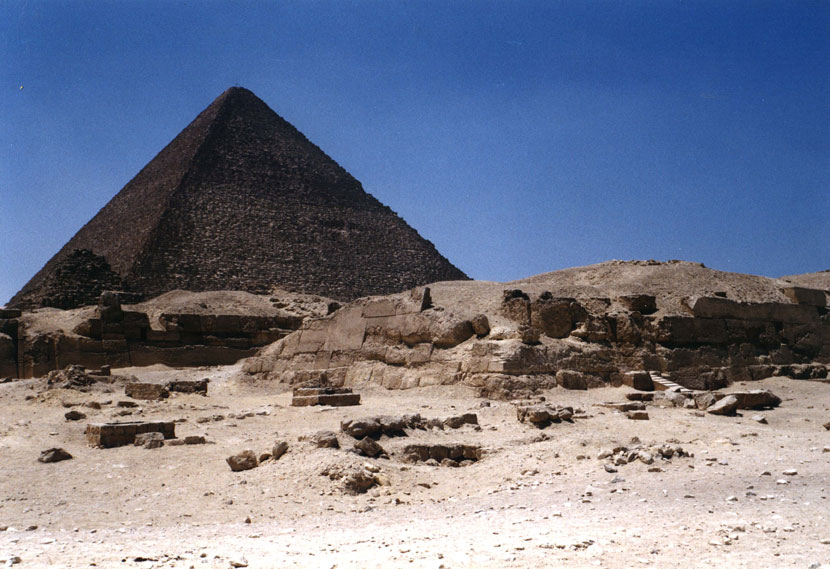
n.b. Photos of the pyramids are sometimes "doctored"
Imhotep (of recent "The Mummy" fame)

Imhotep was actually architect to King Djoser in around 2700 BC.
Imhotep is credited with building the first monumental structure in stone, the Step Pyramid at Saqqara. Much respected as a man of learning, and later revered as a god.
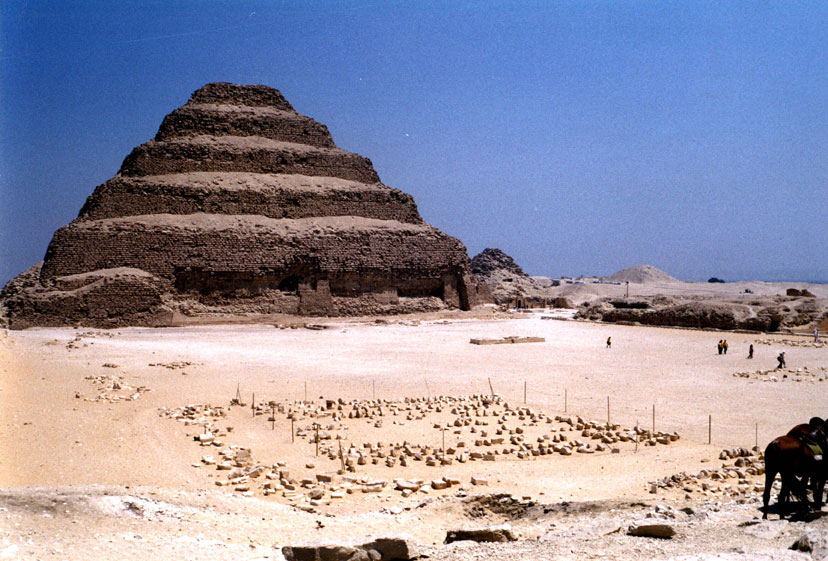
Tomb of Hatshepsut in Deir el Bahri - cut directly into the rock - a lot of it is restoration
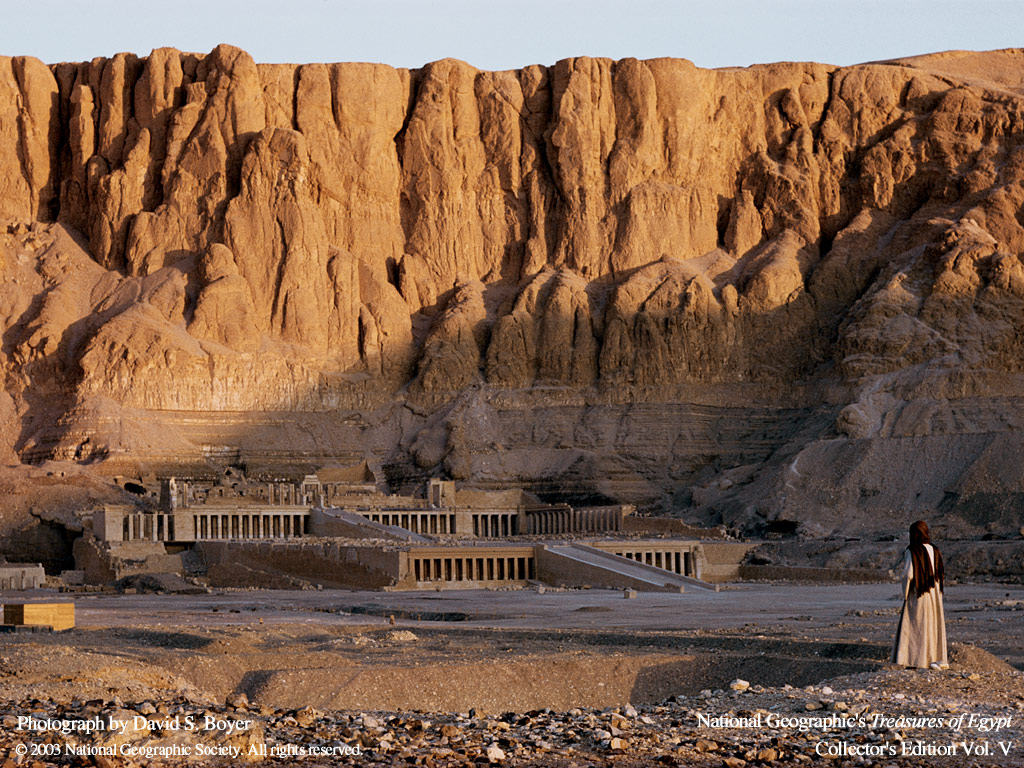
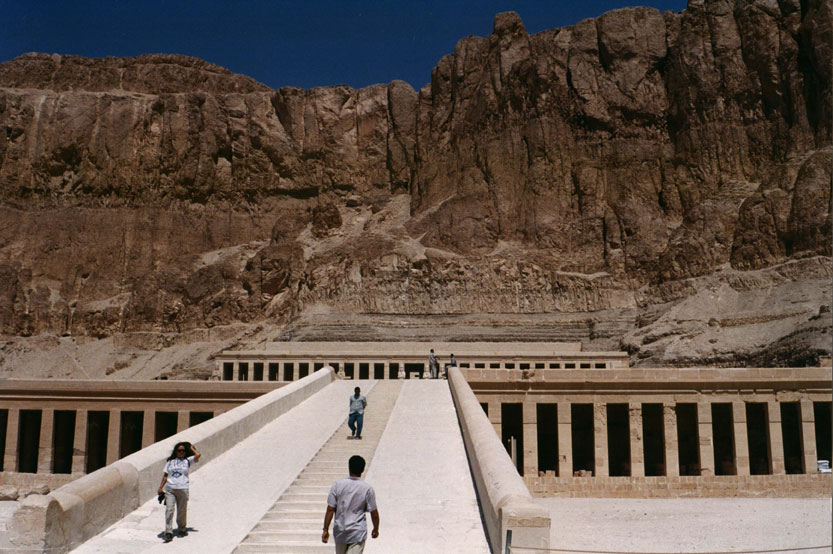
The issue of damnatio memoriae - destroying memory - can been seen in Hatshepsut's tomb
Reminds us that... ancient people also had a past and a future

Interesting feature of many monuments: reused.
Hemmed in by massive papyrus-bundle columns, this granite colossus was
originally carved for Amenhotep III and two centuries later was recut for
Ramesses II. Standing by the left leg of the king is Queen Nefertari. Of the
eleven surviving standing colossi in the first court at Luxor Temple, five are
statues of Amenhotep III that Ramesses II "renewed" for his courtyard. The reuse
of the monuments of an earlier ruler was not always a hostile usurpation or the
outcome of damnatio memoriae, but could also be a recutting of an ancient
monument in order to renew the creative powers of the temple."
http://www-oi.uchicago.edu/OI/DEPT/PUB/CATALOG/LE2.10.html
Abu Simbel – huge temple, ‘rediscovered’ 1813, cleared of sand in 1817, later relocated/rescued from the Aswan High Dam.
Very large Ramesses II temple: note images of wife, daughters, sons, prisoners

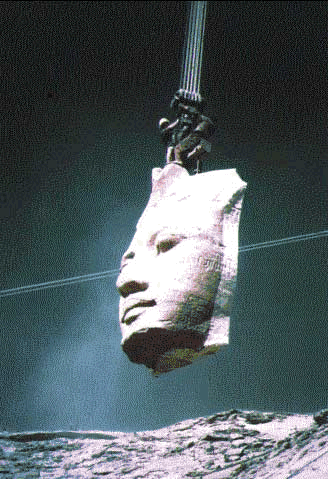
Moving Abu Simbel
Unfortunately, water (from moving the Nile around) is doing more damage to structures that can't be moved...
http://www.guardian.co.uk/science/story/0,,1702789,00.html?gusrc=rss\
New discoveries in Egypt all the time... even, sometimes, in places which have been very well studied:
e.g. The Valley of the Kings
http://www.thebanmappingproject.com/articles/
Used for over 500 years in the New Kingdom, Dynasties 18-20, as burial place of pharoahs... pyramids were no longer the preference
(interesting article on later reuse of the Valley - neat ancient graffiti: http://www.thebanmappingproject.com/articles/article_2.4.html )
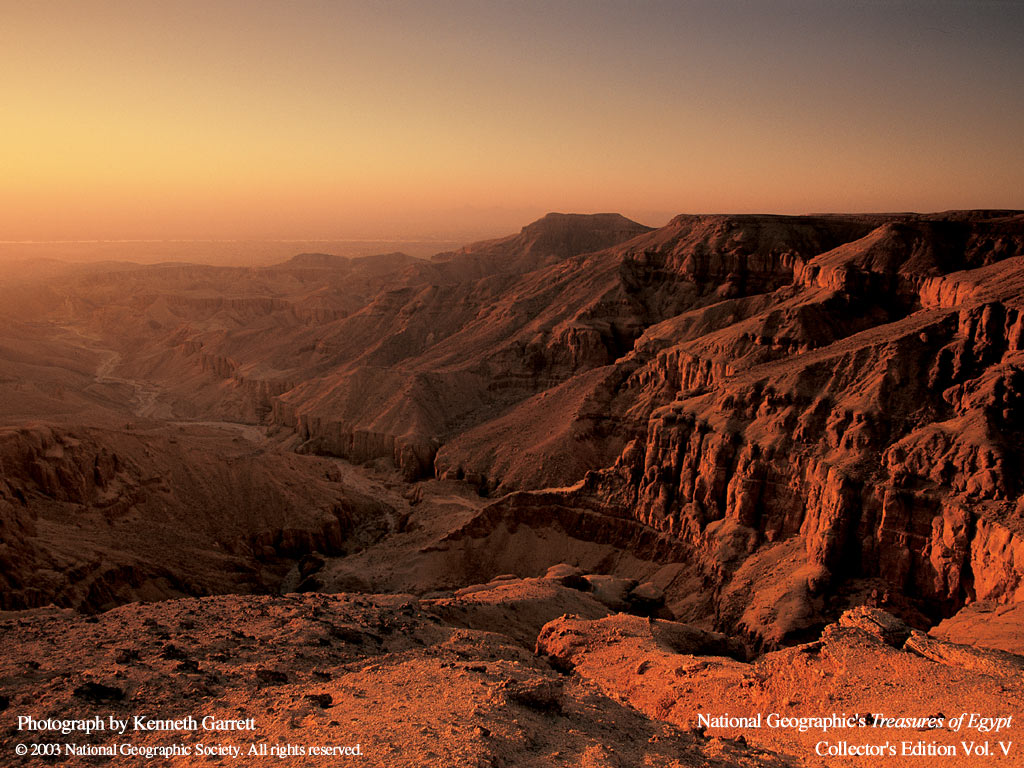
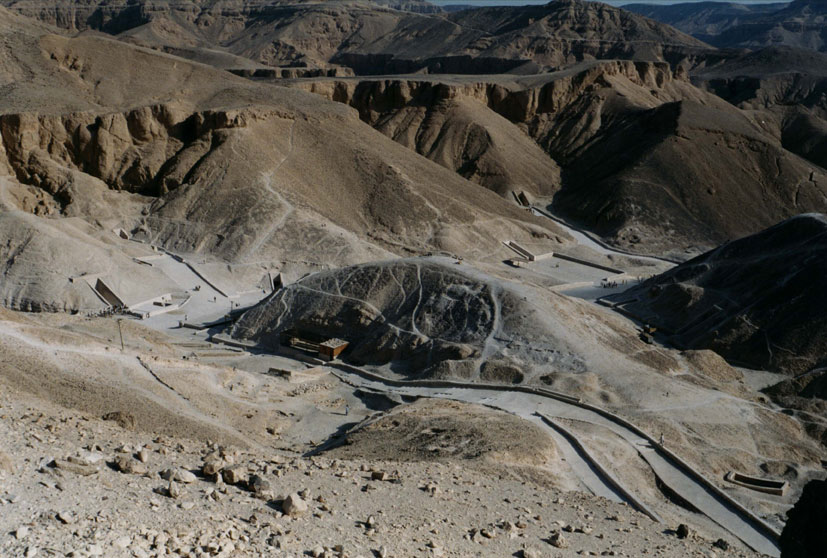
Theban Mapping Project: http://www.thebanmappingproject.com/
KV62 = Tutankhamun's tomb http://www.civilization.ca/civil/egypt/egtut01e.html , http://www.tutankhamun-exhibition.co.uk/
New neighbour: KV 63 discovered just recently:
article, http://news.bbc.co.uk/2/hi/middle_east/4700032.stm
Last big discovery in the area was the extent of KV5, in 1995: http://dsc.discovery.com/convergence/rameses/slideshow/slideshow.html
Religion
- creation myths... several, because of the fusion of multiple traditions (easy with polytheism)
e.g.
Heliopolis - watery swirling chaos called Nu... from which rose Atum, the sun god/goddess, who then created more god/desses by mating with his own shadow ... he spat out his son (Shu, air) and vomited up his daughter (Tefnut, moisture)... Shu and Tefnut produced Geb (earth) and Nut (sky) ... Geb and Nut produced Osiris, Isis, Seth, Nephthys
(fun version: http://www.ancientegypt.co.uk/gods/story/main.html )
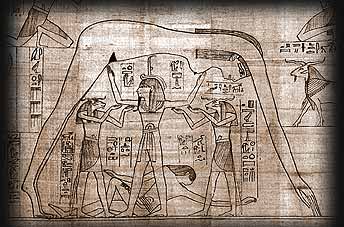
- very interesting parallels with Christianity
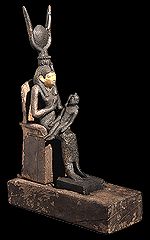 and
other religions (see Tom Harpur's book, The Pagan Christ)
and
other religions (see Tom Harpur's book, The Pagan Christ)
- continuity and change
- the case of the Amarna 'revolution' was only one upheaval, albeit the most dramatic... Amenhotep IV = Akhenaten Worhip of the Aten, the sun. Moved capital to Amarna. n.b. an attempt to introduce monotheism OR an attempt to consolidate power? general opinion says it was more about power and disempowering the priests, who were gaining too much political influence
- roles of priests - performing the necessary rituals for the gods and pharoahs... giving offerings, etc. not a pastoral/preaching kind of role
- religion and politics significantly intertwined... changes in one would affect the other...
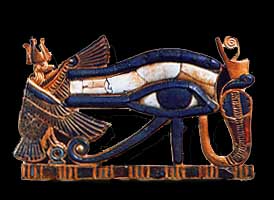
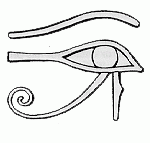 -
interesting aside... Eye of Horus. Horus was determined to avenge his
father's murder at the hands of his evil uncle Seth. Battle -- Horus' eye was
torn out and shredded into 64 pieces.. which Thoth healed... hence the eye of
Horus represents wellness and unity.... was then used by Galen (2nd century
Greek physician).... and then became the Rx sign.
-
interesting aside... Eye of Horus. Horus was determined to avenge his
father's murder at the hands of his evil uncle Seth. Battle -- Horus' eye was
torn out and shredded into 64 pieces.. which Thoth healed... hence the eye of
Horus represents wellness and unity.... was then used by Galen (2nd century
Greek physician).... and then became the Rx sign.

GODS
Not stable. Morphed and fused, in response to politics. e.g. Horus and Seth.
Many and varied! How to tell them apart? Their hats.
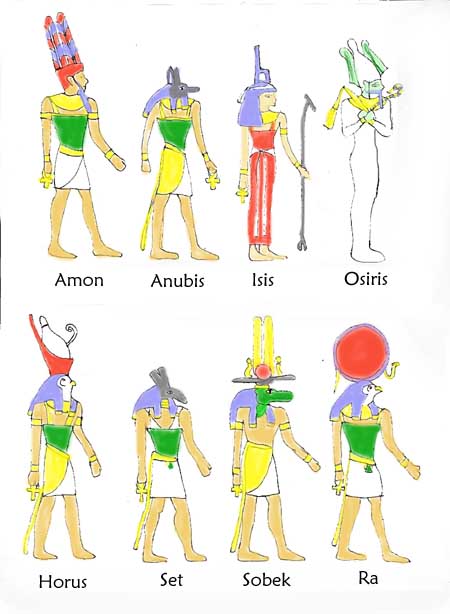
Amon - The creator god. Anubis - God of mummification.
Isis - Mistress of Magic. Also the wife of Osiris and mother of Horus.
Osiris - God of farming and ruler of the underworld.
Horus - The sky god. Son of Osiris and Isis.
Set - God of disorder. An enemy of Horus.
Sobek - The crocodile god.
Ra - The sun god.
Nice gallery here: http://www.exn.ca/egypt/thumbs.asp?cat=Art
BURIAL RITES
Predynastic: "Ginger" from the BM. 3400 BC, on display at BM since 1900.
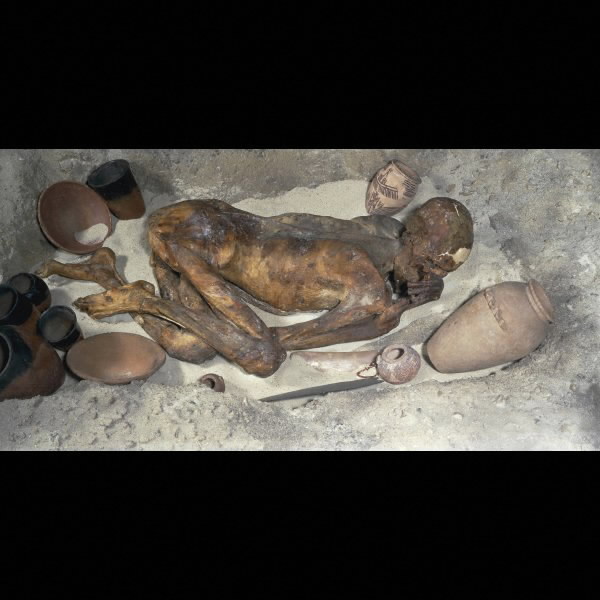
Later: Deliberate mummification.
n.b. they also mummified animals.
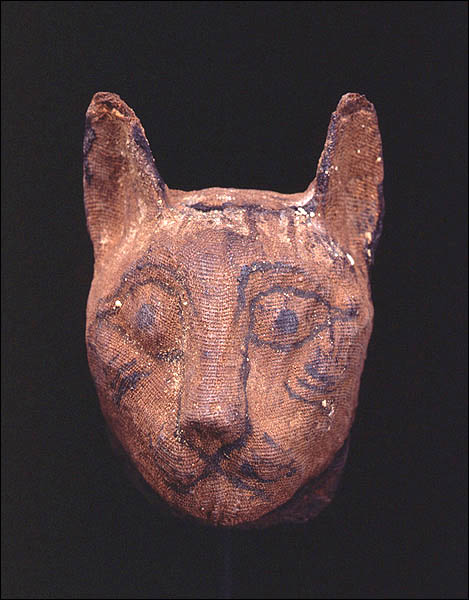
Want to adopt an animal mummy? You can! http://news.bbc.co.uk/1/hi/world/middle_east/1254835.stm
Want to be mummified? You can! http://www.summum.org/mummification/
Artifacts of mummification:
Bronze probe, inserted through the nose.

Canopic Jars: for storing internal organs with (but not in) the body.
Sons of Horus, four minor gods who protected the organs that they contained. They are: the falcon-headed Qebhsenuef (intestines); the jackal-headed Duamutef (the stomach); the baboon-headed Hapy (the lungs), and the human-headed Imsety (the liver).
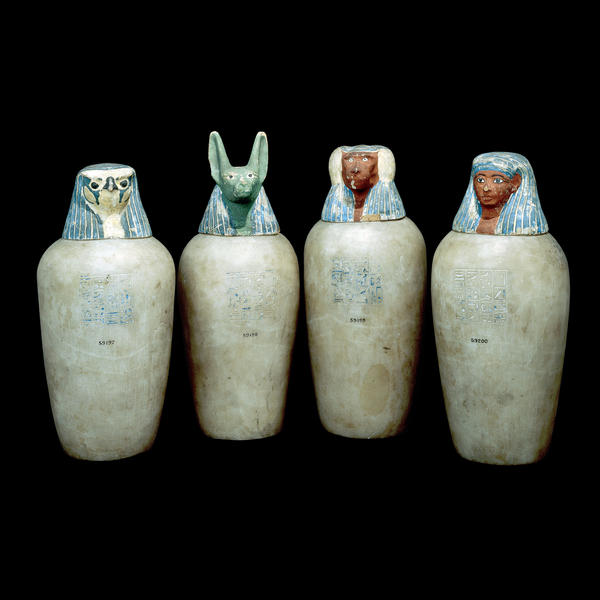
Scarab
New Kingdom, 1550-1069 BC
Amulet placed on the torso of the mummy, to protect the heart -- the seat of intelligence, emotion, and memory.

Beliefs
Why mummification?
Egyptian beliefs about life and death were very elaborate.
Death and rebirth – cyclical.
Elements of the individual that live on after death of body:
ba – linked closely to body – human-headed bird that journeyed to underworld – could die a second death
ka – individual’s twin self, vital force - memory of the deceased, and the physical representations that served to keep this memory active – ka could die a second death if forgotten
rn – the name
swt – the shadow
hk3 – personal magic
- death was a temporary state – the dead could affect the daily affairs of the living- letters to the dead were written and left at their tombs, e.g. a man asking his dead wife to intervene on his behalf with the Lords of Eternity.
So, the rituals:
1) public grief, and preparations of the body (up to 70 days) – mummification to make the body lifelike and lasting, a vehicle for the spirit if necessary – in New Kingdom Egypt, this resurrection took place every night
2) funeral – Opening of the Mouth ceremony, reanimation of the dead, ability to speak, but at the same time, the separation from the world of living
3) then maintenance of the dead in the afterworld, with continuing rituals at the tomb chapel, offerings of food etc. to sustain the dead one.
(Meskell 2002, Private Life in New Kingdom Egypt.)
The Ba

Ba, Egypt 2nd century AD.
BM. "The Egyptians believed that a person's essence or soul was composed of several elements. These became separated at death. The ba was one of the elements of the spirit, which encompassed the personality and emotions. It stayed close to the body of the deceased and was eventually reunited with other elements, to live eternally in the Afterlife"
Changing practices and representations
Roman Period Egypt, Mummy Mask, AD 100-170
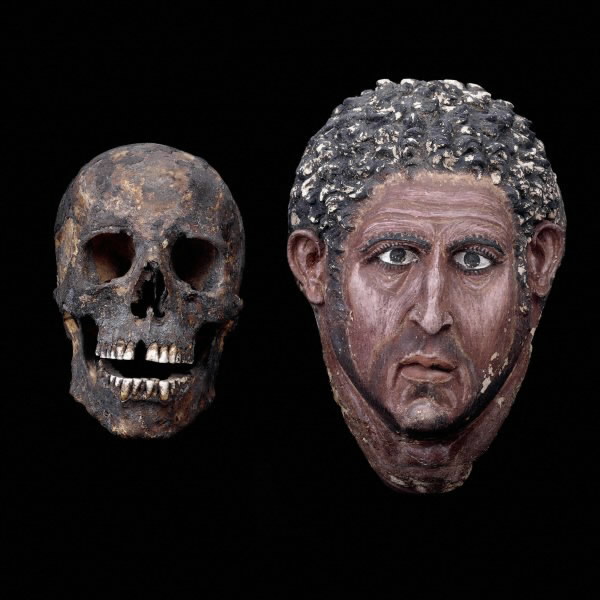
The Long Afterlife of Mummies...
- looting in antiquity...
- C18-19 antiquarians and other uses, e.g. "mummy"
- current archaeology and public display
e.g. The Long Trip of Ramesses I
http://carlos.emory.edu/RAMESSES/
On October 26, 2003, the mummy that is believed to be Ramesses I returned to Cairo:
http://www.cbsnews.com/stories/2003/10/27/world/main580103.shtml
Ramesses I:
- born mid-14th century BC, near modern Alexandria - New Kingdom times
- was originally named Paramessu, and was a soldier (not of royal birth)
- when Akhenaten died, and Tutankhamun assumed the throne and then died... the throne went to Ay and Horemheb
- Paramessu became a prominent soldier and political leader and co-regent, and upon the death of Horemheb, assumed the throne and took the name Rameses (Ra/the Sun God has fashioned him) and thus began the 19th dynasty
- became a powerful pharoah but died before his own tomb was complete... and... when that tomb was discovered in 1817 by Belzoni, there was almost nothing left, and his mummy was missing... (not unusual!)
- his legacy includes a long line of pharoahs named Rameses after him... the "Ramesides"... particularly famous ones include Seti I (his son) and Rameses II (his grandson)
The Mummy Who Would Be King - Nova, 2006
First part in lecture, second part in tutorial with discussion tomorrow.
Supplementary materials/transcript available: http://www.pbs.org/wgbh/nova/mummy/
If you miss it and/or want to watch it again, it's airing again on PBS in early Feb... check listings: http://www.pbs.org/wgbh/nova/
As you watch, take notes and consider (and be ready to discuss tomorrow):
- the nature of museums in the 19th century compared to today
- how a dead Egyptian king ended up in a place of amusement in Ontario
- all the different camps (collectors, TV networks, etc.) that ended up interested in the identity of this mummy
- the ethics of buying and selling ancient human remains
- the analytical methods used to discover information about the mummy, and the historical documentation
- the difference between establishing a general identity (a male mummy of X age, mummified in X style, probably royal, etc.) and a specific personal/historical identity (Ramesses I)
- why does it matter (and to whom) whether this is Ramesses I or not? If it wasn't royal etc., do you think the mummy would have been sent back to Egypt? Does an ancient king deserve special treatment today, more special than an ancient commoner?
-----------------------------------------------
Links:
British Museum: http://www.ancientegypt.co.uk/menu.html
Saqqara: http://www.culture.gouv.fr/culture/arcnat/saqqara/fr/intro_flash.htm
Egyptian art: http://www.metmuseum.org/explore/new_pyramid/PYRAMIDS/HTML/el_pyramid_Intro.htm
Eternal Egypt: http://www.eternalegypt.org
http://www.digitalegypt.ucl.ac.uk/Welcome.html especially
http://www.digitalegypt.ucl.ac.uk/religion/index.html
http://www.sacred-texts.com/egy/ebod/index.htm
http://www.sacred-texts.com/egy/pyt/index.htm